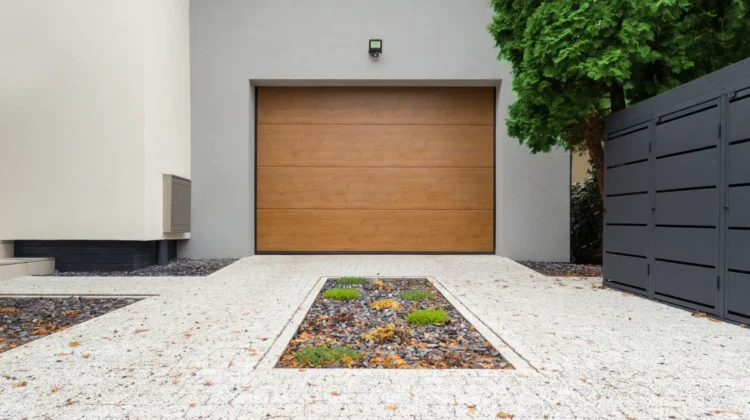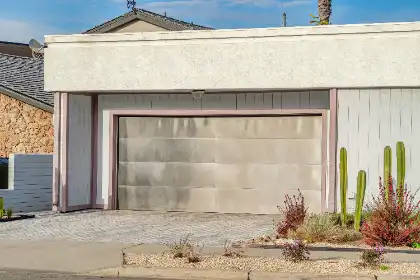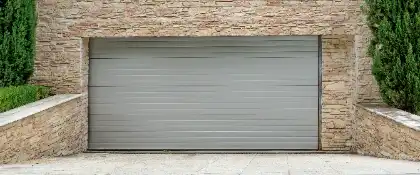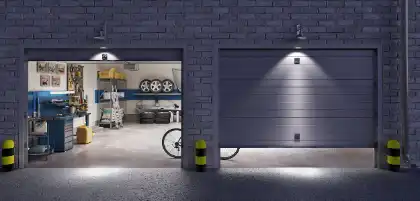
Eco-Friendly Garage Doors: Materials & Upgrades That Matter is not just a trending topic—it’s an essential part of sustainable home improvement. Garage doors cover a significant portion of your home’s exterior, playing a direct role in energy consumption, comfort, and curb appeal. Choosing eco-friendly garage doors means making decisions that impact both the environment and your day-to-day living.
Why Eco-Friendly Garage Doors Matter
- Sustainability: Opting for environmentally responsible materials and upgrades helps reduce your home’s carbon footprint.
- Reducing Home Energy Consumption: Well-chosen garage doors with proper insulation and sealing keep heat in during winter and out during summer, directly affecting your energy bills.
- Home Value Enhancement: Green building trends continue to gain momentum, boosting property value for homes featuring eco-conscious upgrades.
Wood: A Timeless, Renewable Choice
Wood stands out as a classic option for homeowners who want warmth and character without sacrificing sustainability. When sourced responsibly, wood offers several environmental advantages:
- Renewable Resource: Unlike finite materials, wood can be replanted and regrown, making it inherently sustainable if harvested from well-managed forests.
- Biodegradable: At the end of its life cycle, wood naturally decomposes without leaving behind toxic residues.
- Lower Carbon Footprint: Sustainably harvested wood stores carbon throughout its lifespan, helping offset CO2 emissions.
Notable Eco-Friendly Wood Materials
Modern manufacturing techniques have produced several innovative options for green-minded consumers:
- Accoya®
- Modified using non-toxic processes for exceptional durability and stability. Accoya® is fully biodegradable with low embodied CO2—certified as one of the most environmentally friendly woods on the market.
- Tricoya®
- Made from FSC-certified timber and engineered for longevity. Tricoya® panels resist moisture and decay while using timber sourced under strict sustainability standards.
- Extira® Panels
- Manufactured from leftover wood fibers that would otherwise go to waste. Extira® panels offer high performance with a focus on resource efficiency.
- Shou Sugi Ban-Treated Wood
- An ancient Japanese technique where wood is charred to enhance durability, resist pests, and eliminate the need for chemical treatments. The visually striking burnt finish suits modern, eco-friendly architecture.
The Aesthetic Appeal of Wood Garage Doors
Wood brings unmatched visual warmth and texture to your home’s exterior:
- Offers a wide range of natural grain patterns and stains
- Can be tailored to traditional or contemporary designs
- Instantly elevates curb appeal while supporting sustainability goals
Choosing eco-friendly garage doors crafted from renewable wood combines timeless beauty with responsible living.
Steel

Advantages of steel garage doors
Steel garage doors offer several benefits that make them a popular choice for homeowners looking to implement eco-friendly garage doors:
- Durability: Steel doors are incredibly durable and can withstand harsh weather conditions without warping or deteriorating, unlike wood.
- Long lifespan: The longevity of steel garage doors is another critical factor in their sustainability. With minimal maintenance required, these doors can last for decades, making them a cost-effective and environmentally friendly option.
- Recyclability: Steel is recyclable, which means that at the end of its life cycle, it can be repurposed instead of ending up in a landfill.
Energy-intensive production process
While the production of steel is energy-intensive, advancements in manufacturing processes have led to more sustainable practices. Many manufacturers now use recycled steel, which significantly reduces energy consumption compared to producing new steel from raw materials. This practice helps lower the carbon footprint associated with steel garage doors.
Long lifespan of steel doors
The longevity of steel garage doors is another critical factor in their sustainability. With minimal maintenance required, these doors can last for decades, making them a cost-effective and environmentally friendly option. Their long lifespan means fewer resources are needed for repairs or replacements, contributing to a reduced environmental impact.
When considering eco-friendly garage doors, it’s essential to weigh the benefits against the energy costs of production. Steel offers a balance of durability, low maintenance, and sustainability when sourced responsibly. Its recyclable nature and long-lasting qualities make it a viable option for those looking to reduce their home energy consumption and carbon footprint.
Aluminum

Aluminum is a top choice for eco-friendly garage doors. Its natural properties make it a sustainable option and help reduce energy consumption in homes.
Key Features of Aluminum Garage Doors:
- Lightweight construction makes aluminum garage doors easier to install and operate, placing less strain on automatic openers and hinges.
- Rustproof finish ensures durability in damp or coastal climates, eliminating concerns about corrosion that often affects steel options.
- Minimal maintenance requirements mean less reliance on harsh chemicals or frequent refinishing.
Environmental Benefits:
- Recyclable aluminum significantly reduces landfill waste. Most aluminum garage doors contain a high percentage of recycled content and can be recycled again at the end of their lifespan.
- The production process, while energy-intensive, is offset by aluminum’s ability to be remelted and reused with less energy than required for new extraction.
- Aluminum’s longevity supports a lower carbon footprint by minimizing replacements.
Transportation Emissions Reduction:
- The lightweight nature of aluminum not only simplifies delivery and installation but also slashes transportation emissions compared to heavier materials like steel or solid wood.
- Less weight means fewer trips, reduced fuel usage, and decreased greenhouse gas output during distribution—critical factors in the push for eco-friendly garage doors.
When considering sustainable materials for your next upgrade, aluminum offers a combination of durability, recyclability, and environmental impact that aligns with the principles outlined in “Eco-Friendly Garage Doors: Materials & Upgrades That Matter.”
Insulation
Insulation defines the energy efficiency of eco-friendly garage doors. Without effective insulation, garages act as a thermal bridge, allowing heat to escape in winter and enter in summer—directly increasing your home’s energy consumption and utility bills.
Energy Savings
High-quality insulation creates a barrier that stabilizes temperatures inside the garage. This reduces the workload on your heating and cooling systems, leading to tangible savings on energy costs.
Heating & Cooling Impact
Uninsulated or poorly insulated garage doors can undermine sustainability efforts. Fluctuating temperatures force HVAC systems to run longer, burning more fuel and raising your carbon footprint.
R-Value Explained
The insulating performance of garage doors is measured by R-value—a higher R-value means better resistance to heat flow. When selecting eco-friendly garage doors, pay close attention to this metric. Insulated doors constructed with renewable wood cores or filled with polyurethane foam often deliver superior R-values, directly supporting sustainability goals.
Choosing well-insulated, eco-friendly garage doors is a direct investment in reducing home energy consumption and lowering carbon footprints. This upgrade pays off not only in comfort but in measurable efficiency gains. To maximize these benefits, it’s essential to understand the various types of insulation available and conduct thorough DIY checks for insulation to ensure optimal performance.
Garage Door Openers

Benefits of Energy-Efficient Openers
Eco-friendly garage doors are not complete without energy-efficient openers. These openers consume less power, contributing to significant energy savings over time. Advanced models often come with features like:
- Standby mode: Reduces power consumption when the opener is not actively in use.
- LED lighting: Uses less electricity compared to traditional bulbs, providing bright and efficient illumination.
- Battery backup systems: Ensure functionality during power outages without relying on inefficient generators.
Energy-efficient openers amplify the sustainability of your garage door system, aligning with the principles of reducing home energy consumption and lowering carbon footprints.
Security Enhancements for Garage Doors
Modern garage door openers offer enhanced security features that protect your home against unauthorized access. Key advancements include:
- Rolling code technology: Changes the access code each time the remote is used, preventing code theft.
- Smartphone integration: Allows you to monitor and control your garage door remotely, adding convenience and security.
- Automatic locks: Engage when the door closes, providing an additional layer of security.
These upgrades not only contribute to a more secure home but also integrate seamlessly with eco-friendly practices by utilizing existing technology efficiently.
Sealing and Weatherstripping

Sealing and weatherstripping are the first line of defense against unwanted energy loss in any eco-friendly garage door system. Small gaps around your garage door can let in drafts, moisture, pests, and outside air, undermining efforts to maintain indoor temperatures. For homeowners focused on sustainability and reducing home energy consumption, ensuring a tight seal is essential.
Key benefits of proper sealing and weatherstripping include:
- Lower Energy Bills: Preventing hot or cold air from leaking means your HVAC system works less, directly lowering heating and cooling costs.
- Improved R-Value Performance: Even the best-insulated doors lose effectiveness if there are gaps. High-quality weatherstripping maximizes the R-value of your garage door system.
- Enhanced Comfort: Eliminating drafts reduces temperature fluctuations, keeping your garage more comfortable year-round.
Effective methods to prevent energy loss through gaps include:
- Bottom Seals: Flexible rubber or vinyl strips attached to the bottom edge create a tight barrier when the door closes.
- Perimeter Weatherstripping: Vinyl or foam seals along the sides and top block wind and moisture from sneaking inside.
- Threshold Seals: Installed on the floor beneath the door, these provide added protection for uneven surfaces.
- Regular Inspection & Replacement: Over time, seals wear out—routine checks ensure continued performance.
A focus on gap prevention supports the goals of eco-friendly garage doors by making sustainable materials and upgrades perform at their full potential. This step strengthens efforts toward lowering carbon footprints in every season.
Responsible Manufacturing
Sustainable manufacturing drives the eco-friendly garage door industry toward lower carbon footprints and reduced waste.
Companies committed to responsible practices make a significant difference by focusing on several core principles:
1. Sustainable Sourcing
Prioritizing renewable wood, recycled steel, and aluminum with verified sustainable origins reduces the ecological impact of material extraction. This approach ensures fewer natural resources are depleted and supports managed forests or closed-loop recycling systems.
2. Recycling Standards
Strict adherence to recycling protocols during production minimizes landfill waste. Manufacturers often reclaim scrap metals, sawdust, and byproducts for new components or packaging, closing the loop on material life cycles.
3. Minimal Packaging
Reducing unnecessary packaging materials—especially plastics and non-recyclables—lowers both shipping emissions and consumer waste. Many eco-friendly garage door brands now use recycled cardboard or biodegradable wraps.
4. Efficient Transportation
Streamlined logistics cut down transportation emissions. Bulk shipping, local sourcing, and optimized delivery routes contribute to overall sustainability by reducing fuel consumption and pollution.
Responsible manufacturing extends the positive impact of eco-friendly garage doors far beyond the product itself. These practices support a cleaner supply chain and help homeowners contribute to larger environmental goals simply through their purchasing decisions.
Solar Panels and LED Lighting

Integrating solar panels into your garage setup transforms how you power essential functions. Solar power for garage functions—such as automatic door openers, security systems, or even charging stations for electric vehicles—directly supports sustainability by reducing home energy consumption and lowering carbon footprints. When paired with eco-friendly garage doors, this upgrade reinforces the commitment to using sustainable materials and minimizing reliance on non-renewable resources.
Key benefits of solar panels for garages:
- Independent Power Supply: Operates doors and lighting during outages or peak demand times.
- Cost Savings: Reduces long-term electricity bills, especially in sunny regions.
- Clean Energy: Aligns with the low-carbon footprint goals central to eco-friendly upgrades.
Switching to LED lighting inside and outside the garage is another impactful step. LEDs outperform incandescent bulbs on every efficiency metric:
- Energy Efficiency: LEDs use up to 75% less energy than traditional bulbs, supporting sustainability goals and decreasing utility costs.
- Longer Lifespan: LEDs last up to 25 times longer, which means fewer replacements and less landfill waste.
- Cool Operation: Because they emit less heat, LEDs help maintain cooler garage environments, contributing indirectly to lower cooling demands.
Combining solar panels with efficient LED lighting maximizes the significance of sustainable upgrades, ensuring that your garage aligns with both environmental responsibility and modern living standards.
Recycling and Repurposing Old Garage Doors
Reducing waste is a key component of eco-friendly garage doors. Instead of sending old doors to landfills, recycling and repurposing can extend the lifecycle of these materials and support sustainability goals.
Ways to recycle or repurpose old garage doors:
- Metal Doors (Steel & Aluminum): Scrap yards accept steel and aluminum garage doors, melting down the metals for reuse in new products. Recycling metal conserves resources and significantly lowers the carbon footprint compared to producing new material.
- Wooden Doors: Salvaged wood panels can become garden beds, interior wall cladding, shelving, or custom furniture. When sourced from renewable wood or sustainably sourced, repurposing maintains a low environmental impact.
- Creative Repurposing Ideas: Sectioned panels work as rustic headboards or unique room dividers; windows from old carriage-style doors make attractive greenhouse panels. Hardware such as handles and hinges can be reused on other home improvement projects.
Embracing these recycling and repurposing strategies helps reinforce the importance of eco-friendly garage doors and their role in waste reduction.
When you choose sustainable materials and upgrades, every stage—from installation to eventual replacement—contributes to reducing home energy consumption and supporting a greener lifestyle. Eco-Friendly Garage Doors: Materials & Upgrades That Matter isn’t just about what goes in; it’s also about what stays out of our landfills.
Conclusion
Eco-Friendly Garage Doors: Materials & Upgrades That Matter make a real difference in both sustainability and enhancing home value. Choosing sustainable materials—whether it’s renewable wood, recycled steel, or lightweight aluminum—lowers your home’s carbon footprint and aligns with green living trends that buyers increasingly seek.
Energy-saving upgrades like insulation and LED lighting cut down utility bills while improving comfort year-round.
Responsible manufacturing and recycling practices reduce waste and support a cleaner environment.
Repurposing old garage doors or selecting products built to last limits landfill contributions.
A well-chosen eco-friendly garage door does more than boost curb appeal. It sends a clear message about your commitment to sustainability, making your property more attractive in a market that values environmental responsibility. Upgrading your garage door isn’t just about aesthetics — it’s about making a positive impact for the long-term health of your home and the planet.
